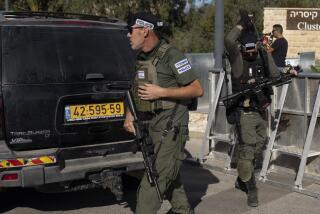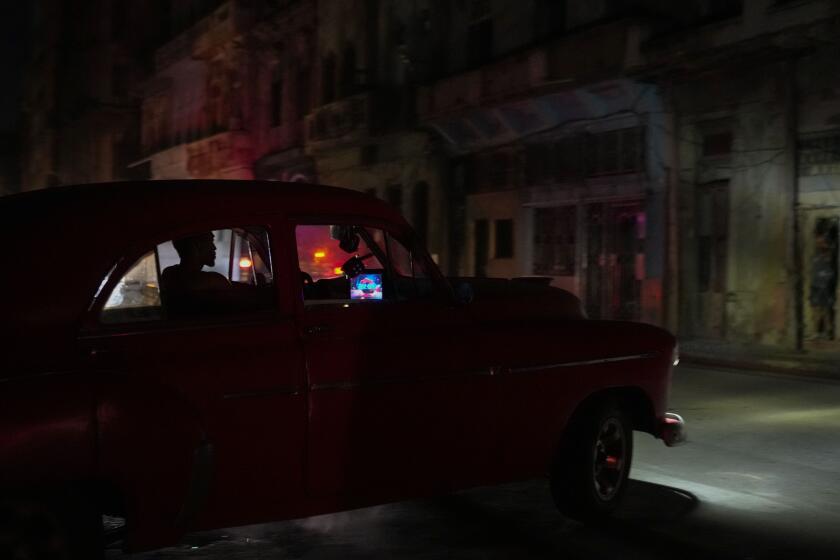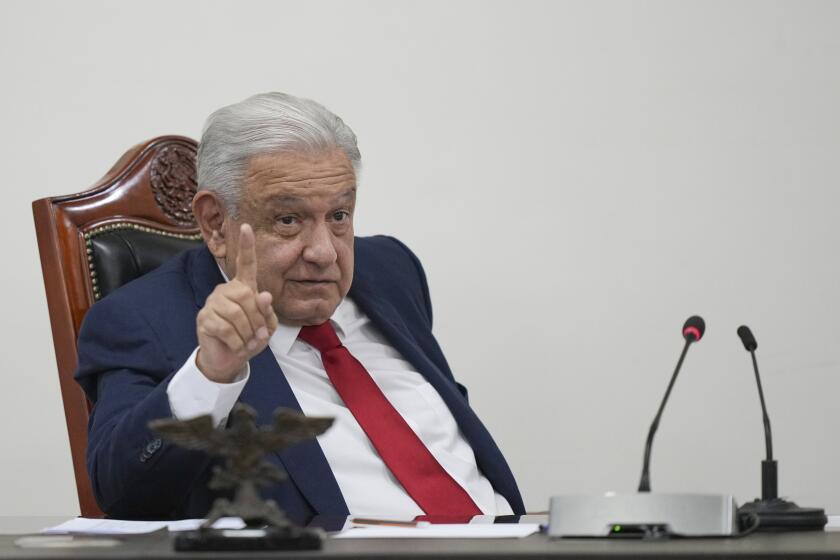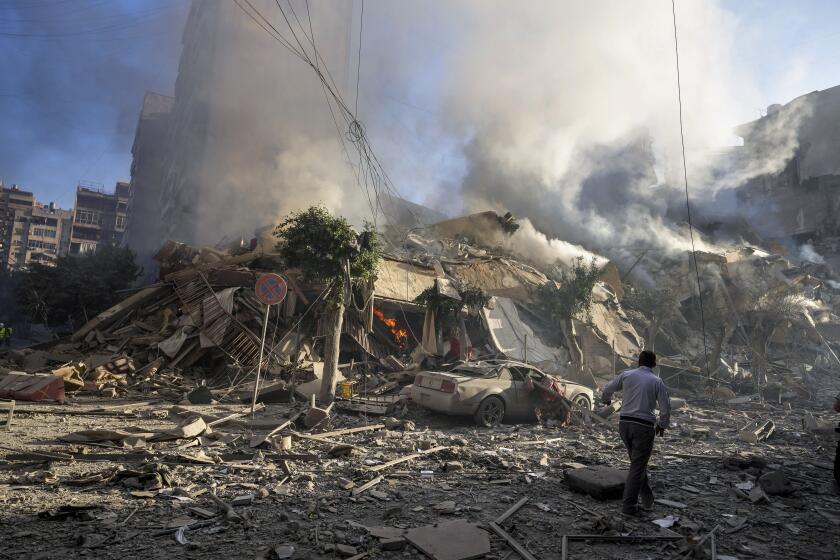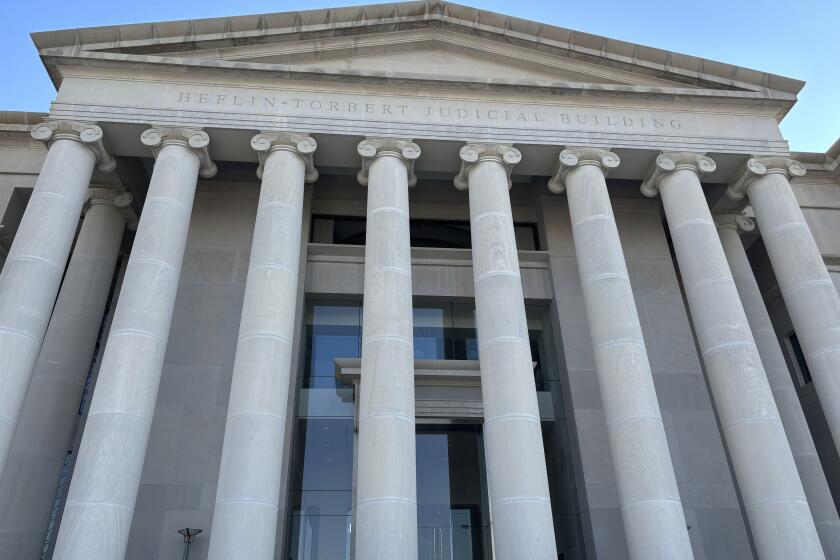Weary Florida Braces for Another Lashing
The picture on the TV set in the dimly lighted bar of Moose Lodge No. 1327 Saturday afternoon was distressingly, alarmingly familiar: a massive white buzz saw of wind, rain and cloud, whirling through the seas on what could be a collision course with Florida.
“Not to wish anything on anybody else, but let this one go way out in the Gulf,” bartender Kathy Reed said aloud.
Nobody in Florida can recall a month like this: two hurricanes, Charley and Frances, that claimed 42 lives and caused $11 billion or more in property damage, and now a third monster storm, Ivan, was plowing northwestward through the Caribbean.
The latest predictions have the hurricane passing far west of the Florida Keys and the peninsula before making landfall in the state’s Panhandle late Tuesday or early Wednesday.
“Normal people really don’t plan for these sorts of things,” Gov. Jeb Bush said Friday, as he urged residents yet again “to prepare and not to panic” in the face of an advancing hurricane. “For people of faith,” Bush said, “this is a time to pray.”
With resignation, exasperation, courage and fear, authorities and ordinary Floridians were bracing for Ivan, though it was still too early Saturday to define the precise path the dangerous Category 5 storm would take. For emergency operations officials, the challenge had become almost surreal: maintain, to the maximum extent possible, recovery and rebuilding operations from Charley and Frances, while battening down for a third storm, which could prove the most deadly of all.
“Everyone’s a little nervous, a little anxious, but when you’re dealing with hurricanes, failure isn’t an option,” said Gordon “Booch” DeMarchi, spokesman for emergency management operations in Lee County, on the Gulf of Mexico, where Charley first touched land Aug. 13. “You fight through the feelings, your fatigue, and you fight on.”
“People are just basically maintaining, doing the best we can with what little we do have,” said Audria Moore, police spokeswoman in Fort Pierce, which suffered major damage from winds and flooding when Frances came ashore on Florida’s Atlantic coast during Labor Day weekend.
For some very unlucky communities like Arcadia, Hurricane Ivan could bring a triple whammy. The rural inland town of 7,000 is the seat of DeSoto County, a 660-square-mile swath of usually placid citrus groves and flat pastureland mainly used to raise cattle. The area was so ravaged by Charley’s winds and Frances’ rains, only 800 of 10,400 homes in the county were believed to have escaped unscathed.
The Peace River, which flows by Arcadia on its way to the Gulf of Mexico, has since brimmed over its banks, endangering another 100 homes.
“Immediately after Charley, our response capabilities were very good, and we were able to start providing [for] immediate needs in a timely fashion -- food and water, for example,” said Cathy Furr, emergency management director for the county. “Then we had to interrupt recovery and go back to preparedness and response for Frances. That’s what’s happening again now, and it’s exasperating.”
DeSoto County now has no functioning shelters, and may need to send residents seeking refuge from Ivan to other counties, Furr said.
Forecasters at the National Hurricane Center in Miami had warned Floridians the entire state could be at risk from Ivan, and as the weekend began, people in many communities formed long lines at gas stations, supermarkets and building supply stores. Residents and tourists had been ordered out of the Florida Keys because earlier estimates had predicted landfall there Monday.
Like many Floridians, though, people in DeSoto County have learned to be wary of placing too much credence in long-term forecasts.
“What’s making us nervous is that it’s taking almost the same path as Charley,” said Donna Hoth, a county official who was in an emergency shelter here when high winds from the hurricane peeled off much of the roof, making the building unusable. “People are scared now. If they even think there’s a storm coming, they are going to take off.”
The feeling of stress may be shared by millions. “Almost every person in the state has been affected in one way or another by Charley or Frances,” said Daniel Armstrong, a psychologist and director of the Mailman Center for Child Development at the University of Miami.
“People have lost homes, we have had some loss of life. There’s been a great deal of loss of control over our lives.”
Now, Armstrong said, “people are looking at the potential of this third storm coming in that is worse than either one of them.”
Many acknowledged that they were simply worn out by what could turn out to be Florida’s “year of three hurricanes.”
David Laubhan, a DeSoto County rancher with 40 head of cattle, lost his barn and pump house to Charley, and nearly a month later hadn’t managed to mend the damage.
“The fences are down, the cows are going where they want to go,” Laubhan said. “With all this rain, it’s hard to get anything done. And living in Florida in summer with no power, no water, no air conditioning, you feel you might as well be in Africa.”
Downtown Arcadia looked like a ghost town Saturday, with storefronts along Oak Street still shielded with the plywood put up for the earlier hurricanes and kept on for Ivan. Shattered glass, torn tarpaper and bits of shingle littered pavements and sidewalks, and storm debris had been stacked in high mounds on side streets. It may be Thanksgiving before the streets are cleaned.
There was a single dominant topic of conversation: the new hurricane. “Here We Go Again: Ivan Approaching,” read Saturday’s headline in the DeSoto Sun, the local newspaper. DeSoto Memorial Hospital, which took a big hit from Charley, announced it would be closing until the new storm passed. At the Moose lodge, where indoor toilets were still out of commission, heads swiveled as soon as the cone of Ivan’s expected route came on the Weather Channel.
“You can stand out here on the road and watch people coming, and see the despair in people’s eyes,” said lodge member Terry Beuer.
“The anxiety is weighing very heavy on the community,” said Rev. David Harris, senior pastor of Trinity United Methodist Church. “You go into a restaurant or store, and you hear the conversation everywhere: ‘What is Ivan going to do? What is the impact going to be? And what are we going to do after that?’ There’s a lot of anxiety, a lot of fear, a lot of concern.”
Others, though, are taking things stoically, the clergyman said. “They say, ‘OK, bring it on,’ ” Harris said.
The shared calamity has given many an opportunity to help. Since Charley, aid and volunteers have flowed to Arcadia from other parts of Florida and outside the state. Last Sunday, Harris’ church held a bilingual service that was attended by Latino migrant farmworkers and their families. “We sang ‘Holy, Holy, Holy’ in English and Spanish,” said the pastor.
“The communities came together and experienced each other like we’ve never done before.”
James Martin, 41, a member of the Moose lodge, said he has been without a job since his boss and family fled town. He has been going around putting plastic sheeting over the homes of older people who lost their roof in the first hurricane and can’t afford a contractor.
The storms, Martin said, are “God’s way of saying we’re all put here as brothers and sisters, and let’s see how many of us realize that.”
Researcher Rennie Sloan in Atlanta contributed to this report.
More to Read
Sign up for Essential California
The most important California stories and recommendations in your inbox every morning.
You may occasionally receive promotional content from the Los Angeles Times.

